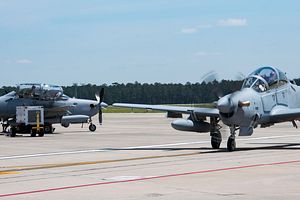The Afghan Air Force (AAF) received two additional Embraer/Sierra Nevada Corporation A-29 Super Tucano light attack aircraft last month at Moody Air Force Base in Georgia, bringing up the total number of A-29 turboprops operated by the AAF to 19.
The aircraft were delivered to support the ongoing training of AAF pilots and ground crews as part of the U.S. Air Force’s Afghan light air support training mission, “which ultimately provides Afghan pilots with the capabilities of finding, tracking, and attacking targets either on their own or in support of ground forces,” according to a statement by the service.
Thirty AAF pilots and 90 ground staff, including maintenance crews, are currently undergoing training in Georgia, overseen by the U.S. Air Force’s 81st Fighter Squadron. The two new aircraft will join the seven currently used for training missions. (One aircraft crashed during a training exercise and has yet to be replaced.) Once the training cycle is complete, the aircraft, pilots, and ground staff will be redeployed to Afghanistan, where they will provide close air support for Afghan ground forces engaged in a prolonged counterinsurgency campaign against militants.
“The Afghan pilots and maintainers we have trained here at Moody have been in combat for over two years now and have done an incredible job,” said Colonel Ryan Hill, 81st fighter squadron commander. “At significant personal risk, they have pushed the Taliban back, regaining several provinces, and all the while having no fratricide or confirmed civilian casualties. This is an amazing accomplishment for a fledgling air force. The Afghans have a lot to be proud of, and are taking enormous steps toward a sustainable peace.”
The U.S. military had to do deal with a number of AWOL (“Absent Without Leave”) cases pertaining to Afghan military personnel sent over to the United States for specialized training in recent years. In addition, in a few cases, Afghans simply declined to return to to their country. For example, a celebrated Afghan female pilot refused to return to Afghanistan following the completion of her training in December 2016. She was granted asylum in the United States last week.
There are currently 12 A-29s operating in Afghanistan. “The A-29 Super Tucano is a turboprop aircraft specifically designed for counter-insurgency operations and can be equipped with a wide array of bombs (including precision guided munitions) and machine guns,” I explained elsewhere. “The aircraft is fairly cheap to operate with one hour of flying time costing around $1,000.” Furthermore, I explained:
In March, an AAF A-29 aircraft dropped for the first time a GBU-58 laser-guided bomb during a close air support mission in the province of Farah in southwestern Afghanistan. Each A-29 can carry up to two 500-pound (226 kilogram) conventional or smart freefall bombs, next to short-range air-to-air missiles, machine guns and rockets.
The U.S. Air Force has so far spent $427 million under its so-called Light Air Support/A-29 Afghanistan Program, primarily designed to prop up the AAF’s close air support capability. The per-unit price per aircraft is around $18 million. According to one report, the A-29s are responsible for about a third of AAF air strikes, with five out of 15 carried out by the turboprops.






























